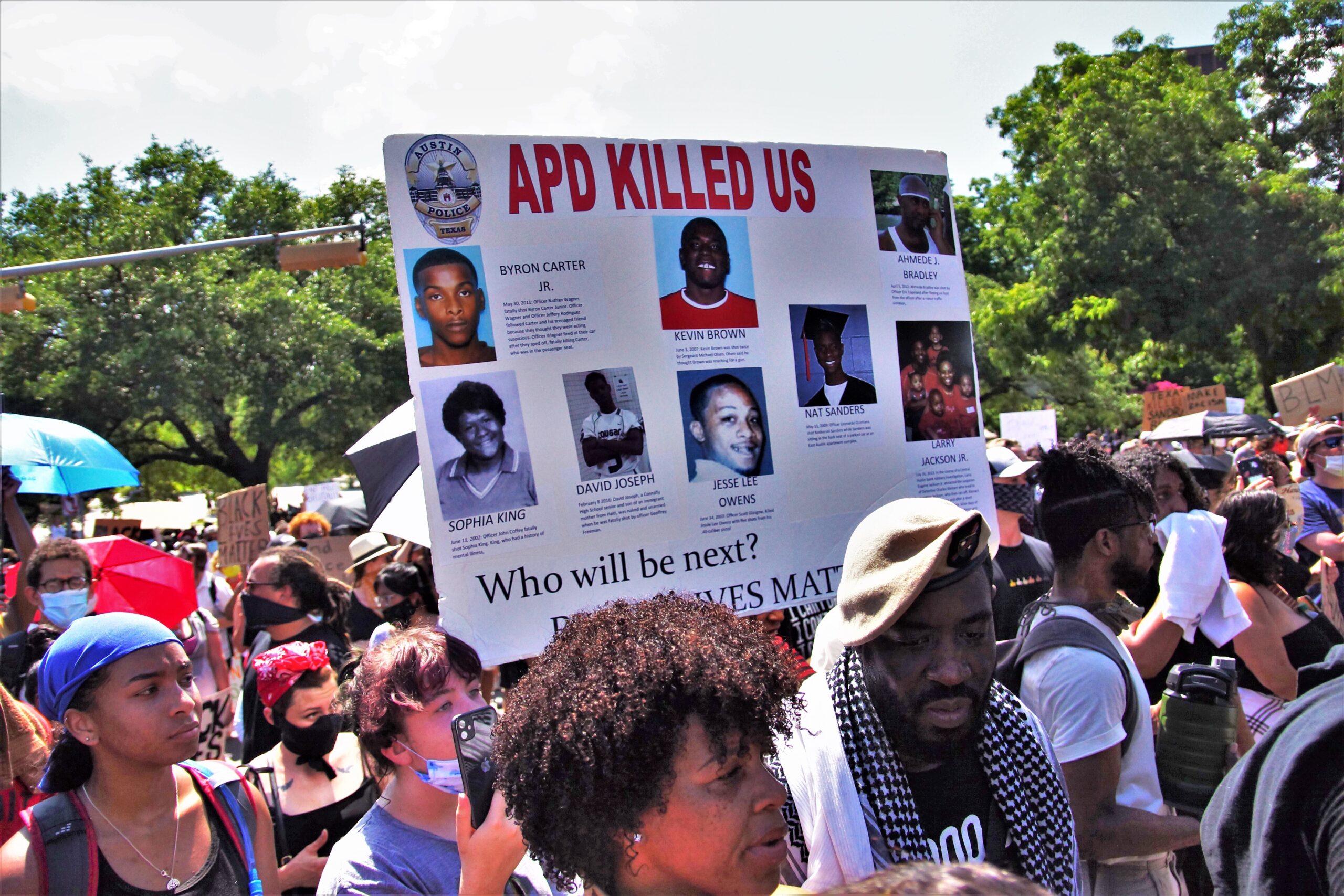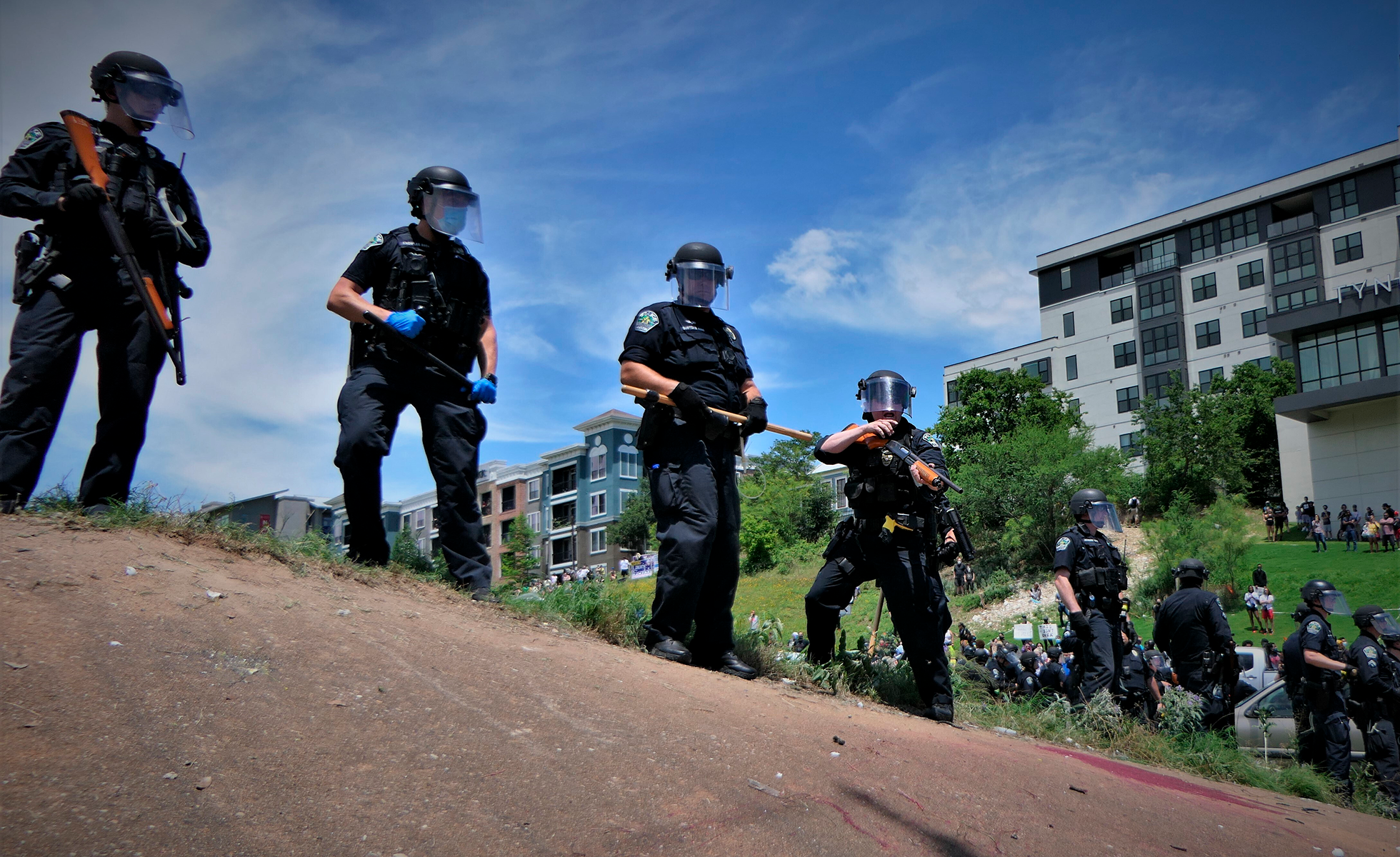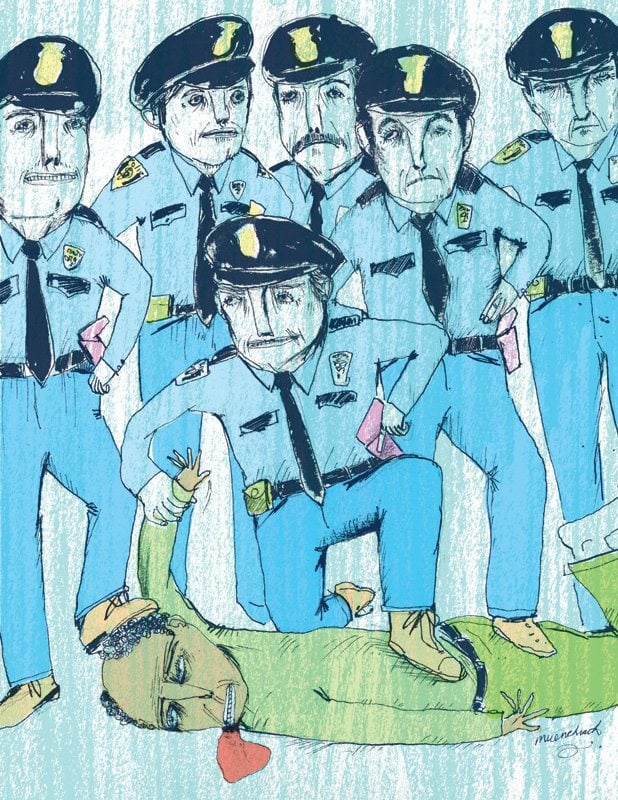
The Horror Every Day: Police Brutality In Houston Goes Unpunished
The Houston Police Department rarely punishes its officers for excessive force.
A version of this story ran in the September 2013 issue.
This story is the second in a two-part investigation into lack of accountability in the Houston Police Department. Read part one, “Crimes Unpunished,” originally published in the July issue of the Observer.
Sebastian Prevot watched helplessly as three police officers advanced on his wife. Prevot was handcuffed and bleeding in the back of a cop car. Half of his left ear dangled where it had been torn from his head. The Houston Police Department doesn’t deny that its officers gave Prevot these injuries during a late-night arrest in January 2012. The only dispute is whether he earned them.
Prevot had been returning home from a night out with a friend. He was two miles from his house when he stopped just past the white line at a four-way stop sign. Two officers in a patrol car tried to pull him over, but he kept driving. Prevot says he didn’t want to pull over and continued home—“going the speed limit, stopping at every stop sign”—because he knew he was about to be detained and have his car impounded.
“My kids had to go to school in the morning,” he told me. “My wife had to go to work.”
Prevot sits across from me in a noisy McDonald’s at dusk. He’s 30, married, with three little boys. In 2009 Prevot was one semester away from getting his bachelor’s degree in marketing when his wife, Annika Lewis, was promoted at her job with AT&T, and the family moved to Houston from Lafayette, Louisiana. Now he takes care of his sons, ages 7, 5, and 4, coaches youth sports and looks for work. His left ear still bears a crosshatching of paler brown where an emergency room doctor stitched it up on January 27, 2012, the night he should have stopped.
I ask Prevot why he anticipated trouble if all he’d done was roll past the line at a stop sign. He looks at me like I’m crazy.
“Obviously, it’s three in the morning,” he says, “so they’re gonna find something. Besides, the inspection sticker on my car was bad.”
Prevot didn’t say he expected to be arrested because he is black, but racial profiling is common. In 2012, almost half the Houstonians arrested during traffic stops were African-Americans, though they make up less than a quarter of the city’s population. Houston Police Department statistics show that white drivers are more likely than black drivers to be carrying contraband, but according to HPD’s annual report on racial profiling—which concludes, “The analysis provides no evidence that officers of the Houston Police Department engage in racial profiling”—officers performed “consent searches” on black drivers in 2012 more than four times as often as on white drivers. A consent search is specifically one made without probable cause.
“When they put those lights on,” Prevot says, “I automatically knew I was going to jail.”
Prevot also kept driving because he was scared. “I mean, I saw the cops,” he says. “I’m from Louisiana, and it was two white boys in the car in a dark area. I wasn’t about to stop nowhere close to there.”
“What were you afraid of?” I ask.
“Getting beat up,” he says. “The same thing that happened.”
As Prevot drove, more police cruisers joined the slow pursuit. By the time he arrived at his house, he estimates 10 cars had him surrounded.
“When I pulled in right in front of my driveway, I got out, hands in the air,” Prevot says. “They already had guns drawn on me. Then they put those up and attacked. From there, they was just beatin’ the bricks off me.”
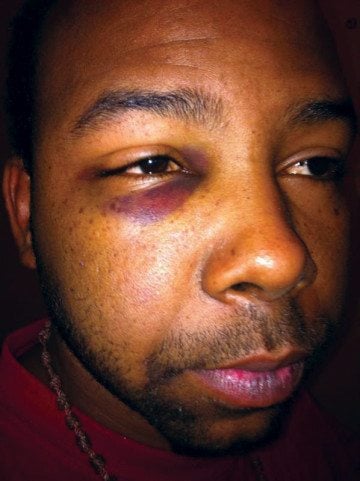
What Prevot describes isn’t rare in Houston. According to citizens, community activists, a veteran Houston police officer and even the president of the local police union, the scenario of multiple officers beating an unarmed suspect happens nearly every day.
What’s rare is for the Houston Police Department to punish its officers for excessive force. An eight-month Texas Observer investigation found that during the past six years, Houston civilians reported officers for “use of force”—the department’s term for police brutality—588 times. The Internal Affairs division investigated each complaint and dismissed all but four.
More surprisingly, HPD rarely believes even its own officers when they claim to have witnessed unjustified violence against citizens. In the same period, Houston cops reported other officers for excessive force 118 times. Internal Affairs dismissed all but 11.
In total, Internal Affairs sustained just 15—or 2 percent—of the 706 police abuse complaints the past six years, according to department records the Observer obtained through public information requests.
In at least 10 of the 15 sustained complaints, the incident was videotaped. Many say—and internal documents suggest—that videotaped beatings have prompted Houston cops to aggressively prevent citizens from recording their behavior.
But beatings take time. They make noise. Witnesses can gather and start filming. Shootings, on the other hand, are fast. They’re usually over as quickly as they begin, which may be one reason why, in the past six years, not a single Houston police officer has been disciplined for shooting someone.
Between 2007 and 2012, HPD officers were involved in 550 incidents in which either a citizen or animal was injured or killed by a police officer’s bullet, according to agency records.
Internal Affairs investigated each incident and determined that every single shooting was justified.
Some of these civilians were armed. Others weren’t. Mark Ames, 23, was unarmed and fleeing when he was shot and injured. Yoanis Vera, 26, was also unarmed when he was wounded. Kenneth Releford was unarmed, but HPD says he charged at an officer while keeping one hand behind his back. Releford, 38, was killed. All of those cases are from 2012.
Another citizen killed by HPD in 2012 was a wheelchair-bound man. Brian Claunch was mentally ill and had only one arm and one leg. Claunch was shot because he allegedly threatened an officer with a ballpoint pen.
Out of 706 complaints about excessive force, HPD disciplined only 15 officers. For 550 shootings, HPD disciplined none. The message is clear: Either Houston police almost never abuse their power, or they abuse it with impunity.
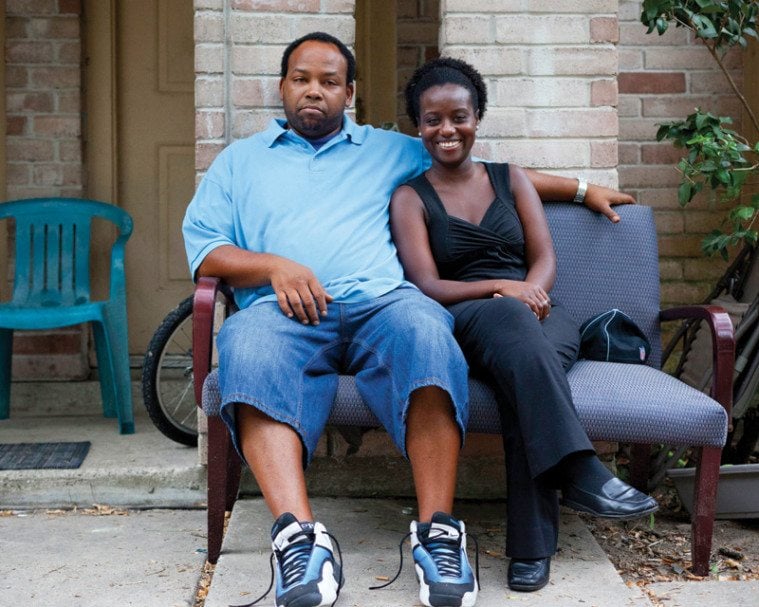
Prevot says after he surrendered, one officer “tackled me into my [car] door and threw me to the ground in the middle of the street. From there, all of them rushed me and started coming to beat me. Hit me with a stick, twisting my ankle in back. While the rest of them were beating me, there’s one in the back twisting my ankle the whole time. Tore tendons and everything. I still go to the doctor for that.
“One will get a lick in and another will get a lick in. It was many, many, many licks. Like, two officers tried to kick me—” his hand hovers over the table and he looks embarrassed—“in the gonads. And I’m out there yelling loud. I guess my wife finally heard me. She came outside with her camera phone. The whole time, they’re yelling, ‘Put your hands behind your back! Put your hands behind your back!’ But they’re standing on my hands. I’m trying to get them to the back like they’re telling me to, but they’re not allowing me. So meanwhile, they continue to whup the shit out of me.”
Jimmy reads the transcript of my conversation with Prevot quietly. Jimmy—not his real name—is a white man, has been an officer with the Houston Police Department for more than 10 years, and doesn’t want to disclose any more than that. He’s disturbed by what he describes as a culture of brutality and racism at HPD but says it’s not safe to criticize the department openly.
Jimmy reads as far as the beating and looks up. “Sounds about right,” he says. “Adrenaline dump, everybody’s chasing him, they all come piling after him. They tackle him, everybody gets their licks in and they put handcuffs on him. That makes sense. Whupping somebody that just ran, that’s like an everyday occurrence. Hell, I’d be surprised if they didn’t.”
I ask Jimmy if it’s plausible that cops would prevent a suspect from complying and putting his hands behind his back. “Yeah,” he says. “I don’t know that it’s normal, and I don’t even know that it’s necessarily deliberate. Could be bad communication. But it’s not exactly innocent either. Cops are starting to learn to perform for the camera. So they know that, like, maybe you can’t see all the details of exactly what’s going on in the scuffle, but if they’re yelling out things like, ‘Give me your hands,’ then it sure looks better after the fact.”
Handcuffing, Jimmy says, “may or may not bring it to a stop. Generally speaking, that’s the sort of limit, when you put the handcuffs on. But even then, it’s not…”
Jimmy trails off. Although we’ve talked many times over several months, he still occasionally seems surprised at what he is about to say. “It’s just, not everybody is necessarily done just because you’ve got the handcuffs on. People will typically stop at that point, but I have heard officers running up to a fight yelling, ‘Don’t put the handcuffs on yet!’ They want to get their licks in.”
“My wife caught all this on camera,” Prevot says. “So by that time, the guy twisting my ankle gave it a final twist.” Prevot mimes wrenching. “And he dropped my foot. The other guys kinda laid off. Then they were like, ‘Get up! Get up!’ And I told them, ‘I can’t get up!’ You know, I’m crying. So they picked me up. They got me in the cuffs now. They put me in the back of this car, and they go over to see what’s going on with my wife. In the back of this car, I could see everything that’s going on.
“Well, I’m looking at them going at my wife. She’s still got her phone. She’s in her own yard. She’s not nowhere near the streets. She’s not interfering or anything, she’s just recording what’s going on. I guess when they seen she was recording them, those three guys, they came behind her and they attacked her. One of them tried to grab the phone out of her hand. She wouldn’t let go, so they twisted her arm behind her and punched her a couple of times. They did her pretty bad. And she’s real short, real petite, like 4 [foot] 11, and at that time maybe 101 or 98 [pounds].
“They got the phone from her, cuffed her up, and put her in a car. They took the phone and took it all the way apart. She had an HTC Evo, and it’s not easy to get the memory card out of the back. They were there for about 10, 15 minutes trying to get it open. Took them a good while.”
Less than two weeks after Prevot’s arrest, the Houston Police Department distributed a memo reminding officers that “citizens have a right to photograph, record, or videotape officers while officers are doing their job. … Officers are further reminded not to initiate an investigative detention or ask for identification merely because a citizen is photographing or recording an officer.”
The memo adds, “If an officer believes a videotape or photograph may contain evidence of a crime, the officer shall consult with the District Attorney’s office to determine if a search warrant is needed to either seize the video or view the contents on the device in question.”
Jimmy says the last bit—don’t take someone’s phone without permission and a reason—is in response to a new tactic cops are using to fight citizen surveillance.
“Are you familiar with the drunk lawyer phenomenon?” Jimmy asks. “Like when you’re at the bar and your friend is giving you crazy legal advice about how to avoid DWI, and it has nothing to do with real law? Well, cops play that game, too, except it’s new ways to prevent people from recording us. Like now they’ll say, ‘Oh, that’s evidence’ and confiscate the phone and tag it into the property room for 18 months.” Jimmy says even if a phone does contain evidence of a crime, the department has equipment that can quickly copy its contents. “There’s no need to sit on it for a year and a half,” he says. “It’s purely punitive.”
But that depends on how you define “need.” The officers who arrested Prevot might have needed to take Annika’s phone to keep their jobs.
In 2011, local news station ABC-13 KTRK aired security camera footage of a dozen HPD officers punching and kicking an unarmed 15-year-old burglary suspect named Chad Holley. The video sparked outrage. National news outlets aired it and community organizers rallied around it as proof that Houston police officers abuse their power. Even the chief of police, Charles McClelland, said publicly that the video “made me sick to my stomach because it was an egregious use of force.”
Twelve officers were disciplined for the Chad Holley beating, seven of whom were fired. Three of those later got their jobs back through arbitration. (For more on HPD’s flawed discipline system, see “Crimes Unpunished,” in the Observer’s July issue.) Four of the fired officers were also indicted for misdemeanor official oppression. One was found not guilty—an all-white jury decided in May 2012 that Andrew Blomberg was not stomping on Holley’s hands but was trying to lift them with the back of his foot—one was found guilty and the other two pleaded no contest. All three received probation.
To Ray Hunt, president of the Houston Police Officers’ Union, those former cops are the real victims. “If Chad Holley had been in school and not burglarizing a house,” he told me, “those officers would still be in this department.”
I asked Hunt how often the Chad Holley scenario—one suspect, multiple officers and “a question about force”—happens.
Hunt, who was a Houston patrol officer for 18 years, replied, “That happens a lot. And I can tell you—myself, two paramedics, my old partner and another police officer were in a similar type thing with a 78-year-old woman on a scene one time. And if that had been videotaped, I can only imagine what people would have thought we were doing to this person. All’s we were trying to do was make sure that her knife was gone and she was handcuffed. … But yeah, a lot of times, when you’ve got a citizen that’s fighting with officers, it may take seven, eight, nine officers to subdue that person. The adrenaline’s going, and it can be bad.”
I asked, “Was the only difference between the Chad Holley scene and scenes that go on all the time that there just happened to be video?”
“Um, I think video is a lot,” Hunt said. Then he seemed to hear himself. “Let me clarify something. I would not say that you’ve got scenes going on all the time that you’ve got persons who are kicking or hitting suspects. I will say you’ve got situations a lot of times out there where you’ve got six or seven officers trying to handcuff a suspect. … Is it ever appropriate to kick or strike a suspect? Absolutely. … Is it ever appropriate to kick or hit a suspect who’s handcuffed and not resisting? Absolutely not.”
Hunt continued, “So then the question is, on Chad Holley’s situation, was he resisting or not? Is it resisting to say, ‘Put your hands behind your back’ and he has them here?” Hunt placed his hands above his head, as Holley did when he was face-down in the grass on the video. “He thinks he’s complying. The officer doesn’t think he’s complying.”
The Houston Police Department’s general orders governing use of force specify, “The circumstances justifying the initial use of force may change during the course of an event. It is the duty of all employees to constantly assess the situation and adjust the use of force accordingly.” But that’s exactly what Hunt says doesn’t happen during an event like Holley’s arrest.
“When that first person runs in,” Hunt says, “it’s very difficult for an officer to stand back and go, ‘Well, hang on, let me think of the penal code…’ You automatically assumed that that person was justified in going in whenever you go in and follow.”
Jimmy agrees. “You’ve got that groupthink going on. All it takes is for one officer to break ranks and go running up there and everybody else is like, ‘Well, I’m not gonna let him run up there by himself.’ There’s a lot of trusting each other’s judgment calls on that sort of stuff and the net result is a lot of piling on. One guy makes a bad call and everybody just goes for it.”
Hunt says this piling on isn’t just automatic—it’s obligatory. Of Holley’s arrest, Hunt said, “If anybody was standing there on the scene when you’re trying to get a felon into custody, I would question that person’s integrity to be a police officer.”
Hunt added, “I want to make sure I’m not quoted as saying we have situations all the time where we’ve got a situation exactly like Chad Holley where he’s being struck both with hands and being kicked. But I’m saying that a lot of times, you’ve got multiple officers trying to subdue a suspect.”
Video, as Ray Hunt said, is a lot. In many cases, the presence of video appears to determine whether a use-of-force complaint is sustained or dismissed.
One jail attendant, Roy Ferrer, had four complaints about use of force dismissed before cameras caught him seizing a handcuffed prisoner by the throat, forcing him to the ground, and kneeing him in the kidneys. That complaint was sustained. Ferrer received a 15-day suspension, according to department records.
Adam Anweiler received two excessive force complaints within a year of each other shortly after joining the Houston Police Department as a jailer; both were dismissed. Then a surveillance camera recorded Anweiler striking a prisoner in the groin, slamming the man’s face into the concrete, and twisting his arm until his shoulder dislocated and his arm broke. Anweiler was fired.
His supervisor, Captain Douglas Perry Jr., was also disciplined. After an employee reported Anweiler’s assault, Perry sent a letter to his superiors stating, “I have completed a thorough review of this incident that included reviewing all relevant documents and watching the video…” and “I’m confident that all Jail Policies were followed and no further actions [sic] is needed.”
Internal Affairs disagreed. When investigators asked Perry why he hadn’t reported the abuse, he claimed the lieutenant with whom he watched the video had “somehow skipped over the portions” that included the beating, according to HPD records. He was suspended seven days.
Officer Angela Horton was simply unlucky. Unaware that she was being filmed by a news helicopter, Horton sucker-punched a handcuffed teenager in the face as another officer led him away. In her official statement, Horton claimed she did not punch the teen but merely pushed his face. “Because the suspect was sweating profusely from trying to elude us,” she wrote, “…my hand slid off of his face.” Horton lost her job.
Through open records requests, the Observer obtained documentation on 11 of the 15 complaints about use of force sustained in the last six years. All but one of those incidents were recorded.
Jimmy, the HPD officer, says this isn’t a coincidence. Without video, he says, excessive force complaints go nowhere. “I’m having a hard time conceiving of any situation in which witness testimony would outweigh the testimony of officers on the scene,” he says. “You could almost have a busload of nuns come by and watch the whole thing, and Internal Affairs could still figure out a way to make it not sustained. They would say, ‘Oh, we don’t really know for sure. You know, the position they were sitting in, the distance they were away, they didn’t really see the full context of what happened.’”
Perhaps the most distressing part is not how many complaints about excessive force the Houston Police Department receives or how few it sustains, but what happens to all the ones they dismiss.
If a complaint is not sustained, it disappears. The complaint, and its investigation, can’t be reviewed by anyone outside HPD or another qualified government agency. Even with all identifying information redacted, members of the public can’t read what a complainant, witness, or officer said about an incident.
That’s because Texas’ Local Government Code allows Houston and other large cities to withhold information about a “charge of misconduct … not supported by sufficient evidence.” Because Internal Affairs decides what constitutes sufficient evidence, Jimmy says, the department has total latitude in cases that don’t involve, for example, publicly broadcast video of an incident.
With full control, Jimmy says, “If you want something to come out a particular way, you can contort the evidence to make an argument for that.”
One of the ways HPD justifies keeping all un-sustained complaints secret is by pointing to the Independent Police Oversight Board. The board comprises four panels of citizens who review every serious or criminal complaint against Houston officers and every allegation of citizen mistreatment. After an investigation is complete, HPD makes the file available to one of the four oversight board panels, which meets to discuss the case. If the panel finds something lacking in the investigation or disagrees with the conclusion, it sends the case back to Internal Affairs, which is required to issue a response.
But that’s the end of it. The Independent Police Oversight Board doesn’t review cases a second time to see if its concerns were addressed, and Internal Affairs isn’t obligated to do anything the board asks. “They’re not in the chain of command,” explains Executive Assistant Chief Michael Dirden, HPD’s liaison to the board. “It’s not a civilian review board with subpoena power and investigative power or anything like that.”
If an oversight board member feels a case is being mishandled, the board’s charter says he or she should report the case to the city’s inspector general. But the inspector general, whose office is responsible for investigating city employee misconduct, has no jurisdiction over HPD. Firefighters, yes, the mayor, yes, but Houston police are explicitly exempt. The inspector general can’t investigate alleged wrongdoing. He or she can only urge the police to do so.
“Under the City of Houston system,” Dirden says, “no one—neither the [oversight board] nor the inspector general or anybody—can tell the chief of police, ‘You know, we don’t like this and you’re going to change it.’ No one has that authority.”
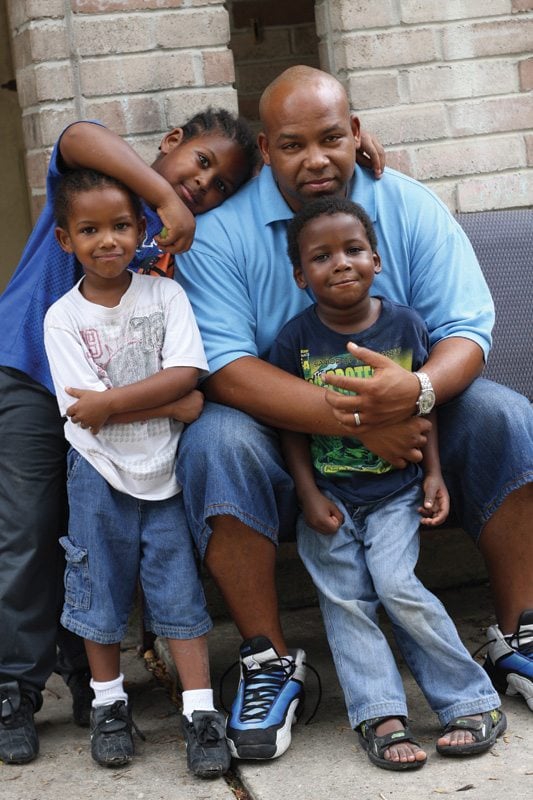
From the police car, Prevot watched HPD officers release Annika. “All the guys are still out there,” he says, “all out laughing and smiling and so forth. Like it’s a big game or whatever.” After Annika went inside the house, “That’s when the guys came back to the car. They looked at me like, ‘Man, your ear’s hanging off!’ They were laughing and playing with it. My hands are cuffed. Everything was swolled up. I couldn’t feel a thing. I couldn’t even feel that. I don’t even know what’s going on, I just know blood’s everywhere. But they were playing with it, making jokes, like ‘Man, they’re gonna have to glue that back together or something!’ It was just a big fun time for them.
“So they drove off, took me straight to the jailhouse. When you’re booked at the jailhouse, there’s a doctor who checks everybody in. Doctor told them, ‘No, you can’t bring him in here. You gotta bring him to the hospital.’ So the officers said, ‘Oh man, you gotta be shittin’ me.’ And the doctor said, ‘No, you gotta take him to the hospital for that ear and everything else that’s going on.’ So they brought me to Ben Taub [General Hospital].
“These guys, they’re waiting on the physician to come and see me. We’re sitting in this room, and they came and took a picture with me. All beat up, handcuffed, ear hanging. … Like I was a freaking trophy head or something. This guy’s got his arm around my shoulder, taking a picture with me. We were waiting there for a while. They were talking noise … saying things like, ‘You were hollering like a bitch!’”
Jimmy reads this part of the Prevot interview and sighs. As a cop, he says, “you’re knee-deep in enough car wrecks, and you see enough bodies torn apart, and you’re around all this horror-show stuff enough times and, like, it just stops being so horrible after a while. You’re around a lot of people who are in horrific, awful, horrible pain and suffering, caused by other people, caused by you, caused by a lot of different stuff and…” He sighs again. “The human heart only has a certain capacity, right? You hit a limit in there somewhere, and it just shuts down. It quits working.
“I’m not going to say that’s not sick and twisted,” he adds. “But it’s a necessary response to the job. It’s a coping mechanism, especially for the guys in patrol. They’re up close and personal with the horror every day.”
In December 2012, the U.S. Department of Justice announced it would review six incidents in which Houston police officers used force against unarmed citizens. Prevot’s arrest was one; Holley’s beating was another; Angela Horton’s face-push was a third. Fourth was Anthony Childress, who says a group of officers stopped him while he was riding his bike and beat him so severely that he lost six teeth and needed 56 stitches. Childress filed an excessive force complaint that was dismissed.
In the other two cases, HPD officers killed people.
When Officer J. McGowan arrived at a reported assault in progress in July 2012, she didn’t know that Rufino Lara was the victim. The officer saw him walking away and followed him, ordering him to stop and show his hands. Witnesses say Lara, 54, turned around with his hands already in the air. McGowan says one hand was tucked into Lara’s waistband. Wherever Lara’s hands were, McGowan shot him dead. In his waistband, she found a beer.
Brian Claunch made violent threats against the officers who came to his home in September 2012 on a disturbance call. Claunch, 45, lived in a residence for disabled men with mental illness. He suffered from schizophrenia and was confined to a wheelchair because he had only one arm and one leg. Yet according to HPD, Claunch backed an able-bodied officer into a corner and jabbed at her with a shiny object. Officer Matthew Marin came to his partner’s aid and killed Claunch with one shot. The object in Claunch’s hand turned out to be a pen. HPD says the case is still under investigation, but a grand jury has already cleared Marin of any wrongdoing.
HPD records consider Brian Claunch to have been armed. The department counts his pen as a weapon. But 49 of the people Houston officers fired on during the past six years were unarmed, even by HPD standards. That’s one in five.
In most cases, the reason the department gave for officers firing on unarmed citizens was “posturing.” The news releases that accompany each HPD shooting use a specific vocabulary to justify the ones in which a suspect is unarmed. The officer “saw several suspicious males” in an area “known for narcotics activity.” The officer saw someone who “matched the description of a suspect” wanted elsewhere. The suspect “made furtive motions,” or “aggressively confronted the officer with one hand behind his back as if he was holding a weapon.” Most often, though, the suspect “appeared to place his hands down the front of his pants” or “began to make movements around his waistband” or “reached into his waistband, as if he was retrieving a weapon.” Why so many unarmed men would rummage in their pants at a moment of crisis is never addressed.
In one case, an off-duty officer saw a man walking up his driveway and suspected him a car thief. The officer says he grabbed his service weapon and ordered the man to show his hands but the man “instead began running at” him with his hands “concealed in his pockets.” The officer fired several shots. Because the suspect escaped, he must have charged the officer, hands in pockets, despite seeing the gun and hearing commands, then made a U-turn after the officer fired and dashed away.
No matter the reason an officer gives for firing, it’s always enough for Internal Affairs and the Homicide Division, which investigate every discharge of a service weapon. In the past six years, HPD officers killed citizens in 109 shooting incidents and killed animals in 225 incidents. In 112 shootings, officers wounded citizens; in another 104, they wounded animals. Of 550 shooting incidents with some kind of casualty, not one was found unjustified.
Hunt says the investigative process that finds all shootings justified is extremely thorough and fair. “When we shoot someone, [Internal Affairs] comes out, [District Attorney]’s office comes out, Homicide [Division], and our attorney comes out, and we agree to do a walk-through of the case,” Hunt says. “We oppose videotaping that walk-through and the reason is, all the facts out there show that two, three days [later], things will be recalled that the officer realizes took place that he didn’t realize that second when his adrenaline is sky-high and he just shot or killed somebody. … We don’t think it’s fair, then, for an officer who—and this routinely happens—two, three days later [to] say, ‘You know what? I forgot to tell y’all, something did happen out there. I remember this.’ … If the defense attorney shows a videotape of [the walk-through], saying ‘Well he didn’t say it here!’ you can’t convince all those jurors that people recall things later.”
But internal documents show that if a recording of an officer’s initial statement about a serious incident differs from a later statement, HPD trusts the earlier version.
Officer Paul Nguyen was off-duty when he got into a fight with a driver he thought was acting unsafely. According to HPD records, Nguyen grabbed the driver, Mr. Melchor, by the shirt, dragged him from the car and held him up by the throat. Then Nguyen calmed down and went home. Melchor called 9-1-1. Because this happened outside of HPD’s jurisdiction, a Harris County deputy constable responded.
In Nguyen’s official account, made well after the incident, he claimed that during the argument, “he saw Mr. Melchor’s hand drop to the right side of his body—which was more concealed—and led Officer Nguyen to believe Mr. Melchor was reaching for a weapon,” according to HPD’s report.
But the Harris County deputy constable who spoke to Nguyen right after the incident was wearing a body microphone. It recorded Nguyen saying he “was aware he had overreacted” and had, in his words, done a “stupid thing,” according to HPD’s report. “Further,” the records state, “Officer Nguyen did not mention or recount at any point his concern that Mr. Melchor was reaching for a weapon…”
Melchor’s excessive force complaint was one of the 15 that Internal Affairs sustained.
After the hospital, Prevot spent the night in jail. The next day, he filed an excessive force complaint against the arresting officers. Some months later, he got a letter in the mail saying his complaint had been dismissed. Prevot’s injuries were apparently a justified consequence of trying to escape. “They said I tried to run when I got out of the car,” Prevot says. “That’s ridiculous. There was no reason for me to run. My whole thing was to try to get back to that house.”
Prevot’s excessive force complaint was one of 691 the Houston Police Department dismissed in the past six years. By now, Prevot has stopped thinking that telling his story is of any use. He believed that when he filed a complaint about use of force, the officers responsible would be punished. But they weren’t. He believed that when the Justice Department said it would review his case, something might happen, but the investigation has already closed without explanation. At this point, Prevot is almost finished serving the two years’ probation he got for evading arrest. He wants to put that night behind him. But he can’t, because now his record bears a felony.
“It’s so hard,” he says. “I just had a great job with Samsung. Great job. They sent me to Dallas for training and everything. … I come back here and three days later, they email me. … They say, ‘We can’t hire you because your background check didn’t go through.’ And that killed me, you know, man? That just killed my little spirit. This happened just three weeks ago, four weeks ago. Now I’m back out there, looking for a job.”
I ask Prevot what he wants to happen. He says, “Can you get my car back? Because they took my car anyway, from in front of my house.” He hangs his head. “You know, it makes me want to cry just saying that because it defeats the whole fucking purpose. [The police] took my car, and I never got it back.”
While Internal Affairs ultimately found the officers’ behavior justified, the men themselves—if only for a moment—might know better.
Prevot says during their hours in the hospital together, the officers’ demeanor changed. “You’re looking at this guy you’ve been with all night long,” he says. “They listened to me talk. They know I’m not a bad guy. I don’t have a record. I didn’t have no weapons. … They knew the type of person that they were dealing with, versus the criminals.”
Prevot had been asking for a cigarette for hours. “By the time we was going to the jail, it was like seven, eight in the morning,” Prevot says. “The guys stopped at the Shell station on the way to the jailhouse and bought me a pack of cigarettes and a lighter. And neither one of them smoked. They were like, ‘Hey man, smoke ’em in the back of the squad car. Usually, you know, we’re not supposed to smoke in here, but we’ll let you do it. You know, whatever.’”
I ask, “Do you think they felt bad?”
“I know they did,” he says. “I mean, they didn’t act like they felt bad. But anybody would.”
